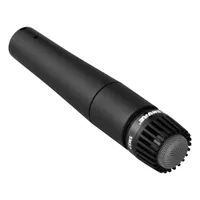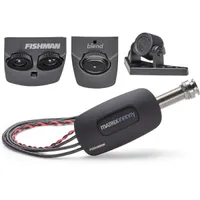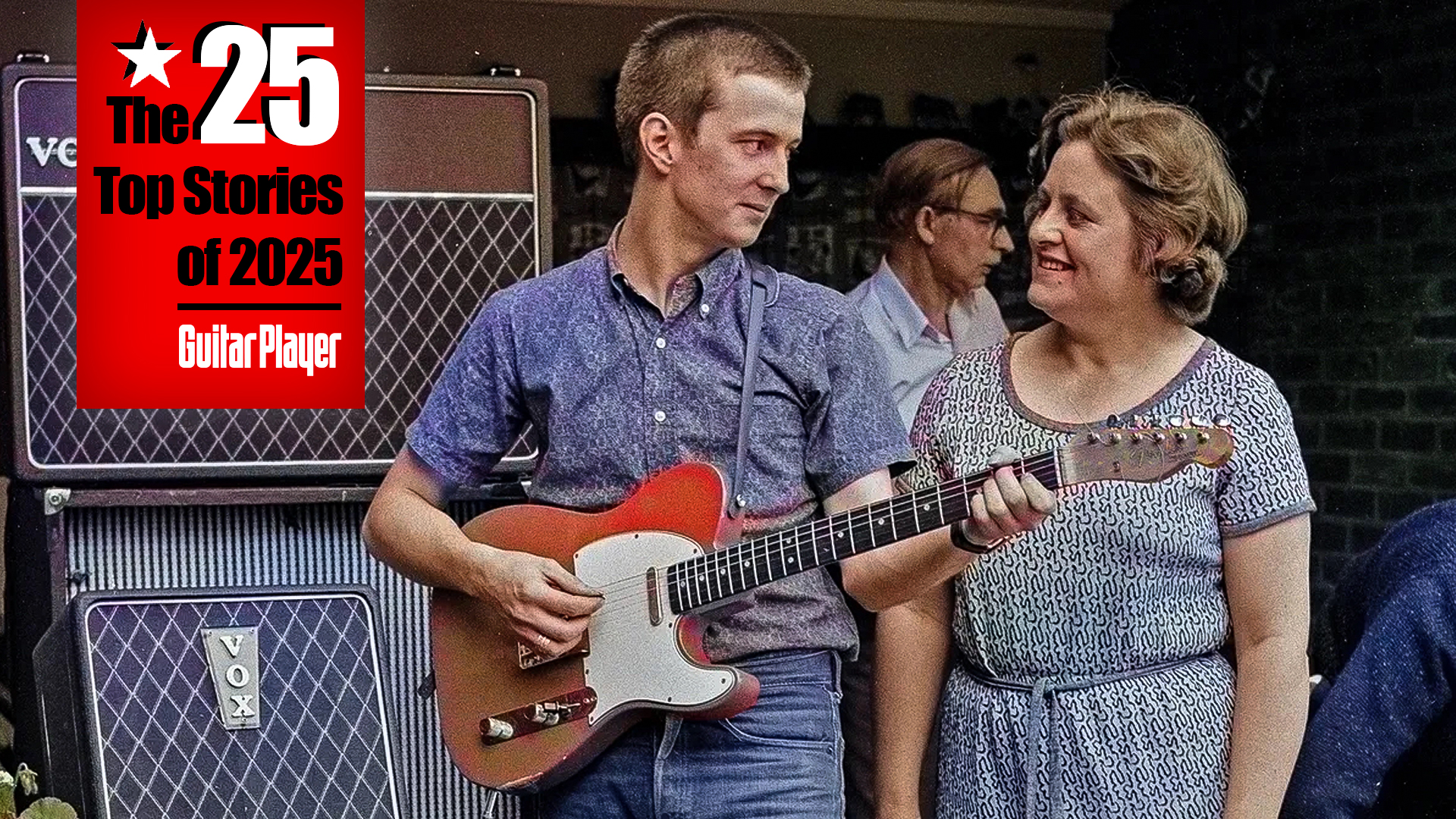Best acoustic guitar mics 2026: our expert pick of the best mics for recording acoustic guitar
Capture every nuance of your playing with these microphones for recording acoustic guitar from Shure, AKG, Neumann, Fishman, and more

Acoustic guitars produce a dynamic range of frequencies, from the bellowing bottom end near the bridge to the delicate twinkling highs as you move toward the headstock. Add in the squeaks of finger movements and the click of the plectrum on the strings, and you've got yourself one of the most dynamic instruments to record. To capture the nuances of acoustic guitar playing, you'll need one of the best acoustic guitar microphones.
There are many different techniques and microphone types you can use on an acoustic guitar, whether you're going for the classic XY stereo configuration, the Blumlein technique, or even more complex mid/side methods. It means picking the right mic for the job is incredibly important, which is where we come in.
Acoustic guitar microphones come in different shapes, sizes, and varieties, each with unique sound and character - much like the acoustic guitars they record. So to make things easier for you, we've arranged these mics by use case, so whether you want to record using a single mic or more advanced stereo techniques, you'll find the right mic for the job here.
Our top picks

The Shure SM81 ticks so many boxes. It’s a dedicated, small diaphragm condenser instrument microphone that’s effortless to position, has a rapid transient response, and boasts a broad, flat frequency response for uncolored, authentic tones.
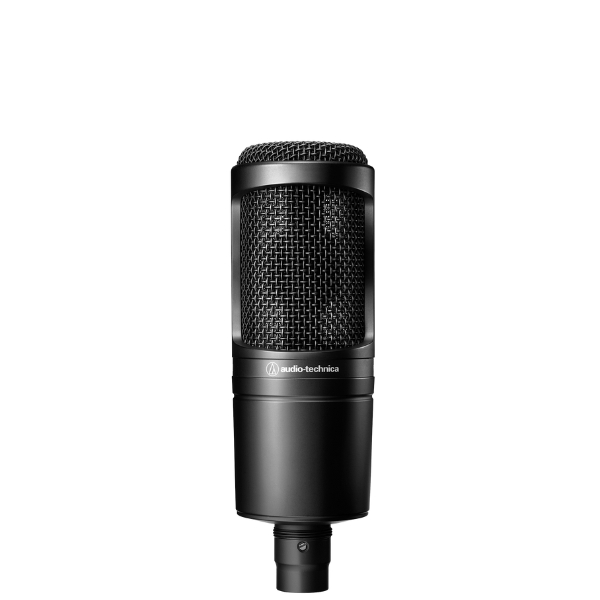
If your budget is really tight, then you can’t go wrong with the Audio-Technica AT2020, one of the most popular budget condenser mics of the past few years. Typically found below the $100 mark, it's a brilliant mic for recording acoustic guitars.
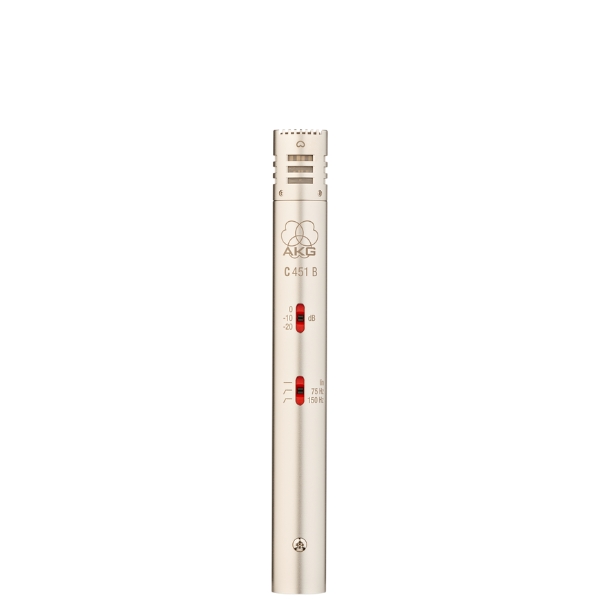
If you're recording using stereo mic techniques, a pair of AKG C451 Bs will give you phenomenal recorded tones. Its ability to capture high-end detail makes it great for recording acoustic guitars, and they're durable too.
Best overall
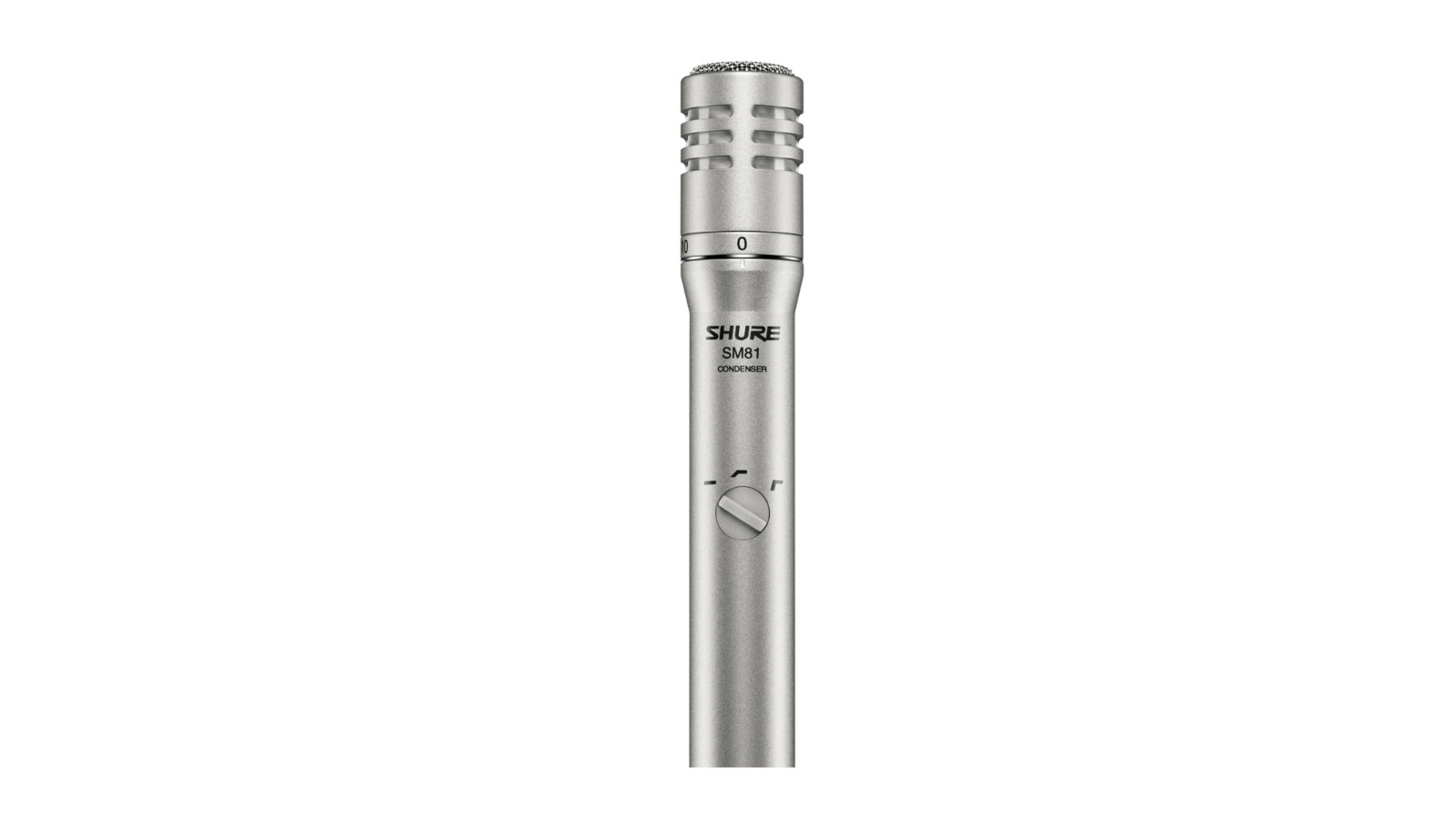
1. Shure SM81
Our expert review:
Specifications
Reasons to buy
Reasons to avoid
It’s hard to fault the SM81 as an acoustic guitar mic. Its slim body makes it easy to both position and aim, plus it’s a joy to stack with others in a multi-microphone setup. The cardioid pattern readily rejects off-axis noise, it boasts a wide 20Hz to 20kHz frequency response and a flat-as-a-pancake response curve for full, colourless, detailed recordings.
Transient response is high, output is high, self-noise is low and it has negligible RF susceptibility. Come on, what more could you want? Well, there’s a 10dB lockable pad and a three-switch high pass filter. In line with all SM series mics, but unusually for a small diaphragm condenser, it’s also ‘field usable’.
This means it’s rugged with a robust vinyl-coated steel casing and fitted with components that have been developed to handle sudden changes in temperature and humidity. It’s just as at home on the stage as it is in the studio. The SM81 won’t break the bank either, which means that you may be fortunate enough to be able to afford a pair. What a great introduction to multi-mic recording.
Best budget
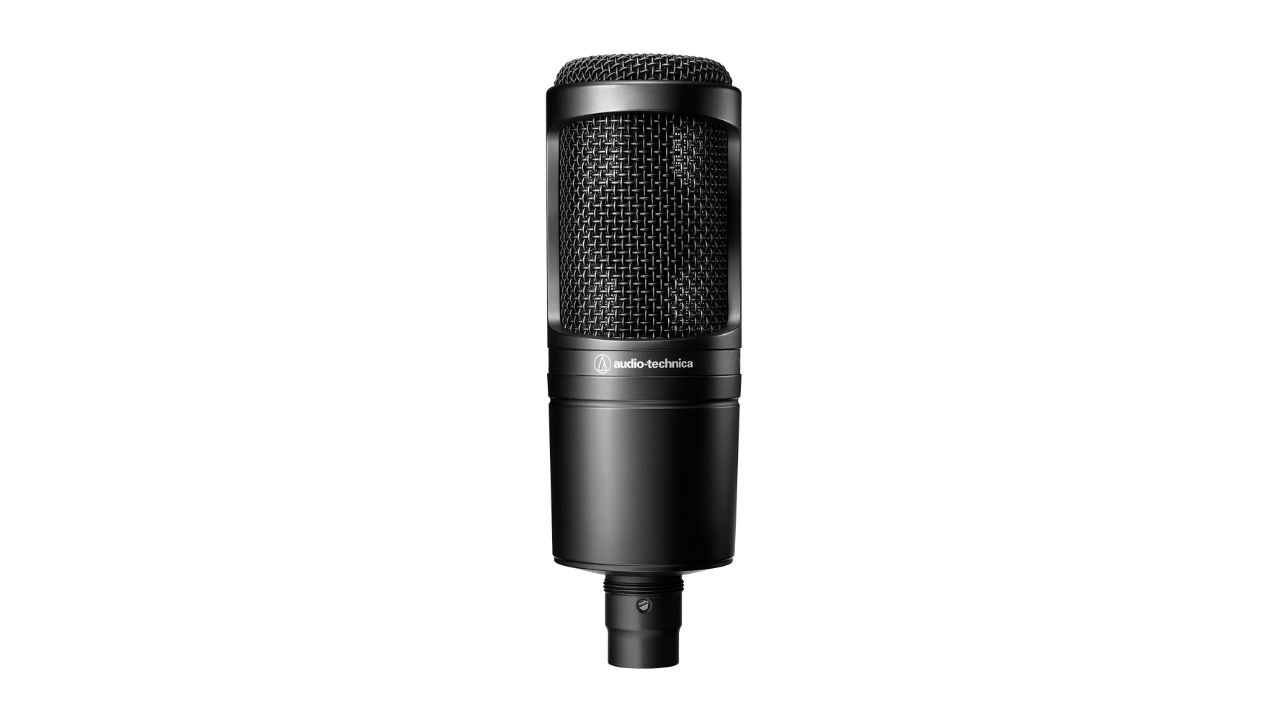
2. Audio-Technica AT2020
Our expert review:
Specifications
Reasons to buy
Reasons to avoid
If you want to start recording acoustic guitar on a tight budget - or any other instrument for that matter - our choice would be the Audio Technica AT2020. It's a large diaphragm condenser that performs well above its price point, making it a top choice for beginners.
It's got a nice and flat frequency response, which means it will capture the natural tone of anything you point it at. There's not much in the way of roll-off on the low end, so it'll really grab hold of the boominess of an acoustic guitar, and on the opposite end a slight high-frequency lift will add plenty of presence and detail to your recorded tones.
It's ruggedly built, so will definitely handle a bit of rough and tumble if you end up using it outside of the home studio. There's not much in the way of accessories though, so if you want a shock mount for it you'll need to purchase that separately.
Best for stereo

3. AKG C451 B
Our expert review:
Specifications
Reasons to buy
Reasons to avoid
The AKG C451 excels at capturing transients and high-end detail, which makes it perfect for recording acoustic guitar. There’s clarity aplenty, and while nobody can deny that this is a bright sounding mic, it’s never brash, tinny or fizzy. Instead, there’s a glorious shimmer that quickly proves seductive.
There are several good reasons why few mics can lift dark-sounding mahogany guitars or mellow cedar-topped instruments better than the C451. It has an ultra-fine diaphragm to catch those fast transients, and the pronounced presence bump after 5KHz goes a long way to explain that characteristic shimmer.
In addition, it has a switchable low-cut filter that rolls off the bass at 75Hz or 150Hz. This mollifies the proximity effect when close miking, so you get all the clarity and sparkle in the world, with none of the muddiness. There’s also a -20dB pad should you need it for particularly loud performances.
The C451 is a conveniently small microphone that’s easy to aim precisely and, according to AKG, it is robust enough to take out on the road with you. It’s also a favourite with drummers for all the same reasons, so don’t be concerned if you see it marketed as such.
Best condenser

4. Neumann TLM 107
Our expert review:
Specifications
Reasons to buy
Reasons to avoid
Yes, we know. That price tag. Still, it’s a Neumann, so quality and workmanship is unquestionable, plus this is an exceedingly versatile mic that can be put to many other uses when you’re not using it for acoustic guitar.
Neumann’s engineers have developed the TLM 107 to be a studio workhorse, a bit of an all-rounder that’s as capable of handling vocals as it is percussion and everything else in between. As such, it’s a large diaphragm condenser that, in a few respects, goes against the grain.
It’s equipped with five polar patterns, and although only a couple are truly useful for capturing acoustic guitar, it’s nice to know that the TLM 107 is so refined that switching between them will barely affect the sound balance. Frequency response is characteristically wide, so no surprises there, but other than a presence boost at around 8kHz, the curve is remarkably flat. It also has outstanding transient response and can handle high sound pressure levels.
The capacity to record transparently and authentically, while having a capsule that’s reactive enough to capture the fastest transients are all qualities that we usually associate with small diaphragm condenser microphones. Similarly, its variable pad and ability to cope with high SPL figures puts it on a level with some dynamic mics. It’s like having a whole handful of mics in one.
These slightly out-of-character qualities make the TLM 107 a wonderful choice for acoustic guitar. In fact, it’s a superb choice for almost any studio scenario. Yes, it’s pricey but it’s so versatile you’re bound to get your money’s worth.
Best ribbon mic

5. sE Electronics Voodoo VR2 Active Ribbon Microphone
Our expert review:
Specifications
Reasons to buy
Reasons to avoid
This microphone was originally a pet project for Siwei Zou, sE’s founder, well-respected classical musician, conductor and composer. He loved the tones he could achieve recording with a ribbon microphone but accepted they had some shortcomings, including lack of top-end response and the requirement for a high-gain, high-impedance preamp.
What Siwei came up with was the Voodoo VR2, an active ribbon mic with an extended high-end response. Some ribbons can sound a little dark because the top-end is rolled off, but not the Voodoo VR2. Its frequency response is broad, from 20Hz up to 20kHz, and its response curve is flatter than Florida.
The result is a ribbon mic that has the highly detailed, extended range of a condenser but sounds totally open and natural. Its active circuitry means there’s no need for a high-spec preamp either. It’s not cheap but it offers the kind of transparent authenticity that we’d happily pay good money for.
If the Voodoo’s price tag doesn’t scare you off, take a look at its big sister the RNRI, which was designed in collaboration with recording tech legend Rupert Neve.
Best tube mic

6. Warm Audio WA-47
Our expert review:
Specifications
Reasons to buy
Reasons to avoid
Warm Audio are known for their ‘homages’ to vintage gear, starting in studio outboard gear and even working their way to classic guitar pedals, but perhaps their finest product is the WA-47 Vintage Tube Microphone, based on a legendary mic from Neumann. To get it out of the way, we would absolutely implore anybody with the budget to invest in a vintage Neumann U47 to do so, but for most of us who have to operate within a budget, the WA-47 does a remarkable job of replicating the Neumann, and for a fraction of the price. In terms of cost compared to quality, we actually think the WA-47 is probably better value.
Lauded for vocal recordings, the WA-47 is also fantastic at recording acoustic guitar—as well as pretty much any other acoustic instrument you can throw at it—and that’s down to unrivaled warmth, clarity, and smooth top end response. When listening to the WA-47’s acoustic recording, you can almost smell the wood of the acoustic, it’s that organic.
And yes, there are genuine vacuum tubes used in operation of this microphone. A Slovak Republic JJ 5751 tube—a low gain, low noise tube—is paired with an American made TAB-Funkenwerk (AMI) USA transformer which contributes to an undeniably ‘vintage’ sound that is truly beautiful when paired with a high quality acoustic guitar.
For those looking for a microphone that thrives in every environment, this might not be for you, as it’s not particularly friendly to travel with, as you have to haul its transformer and thick cable around with you. However, as a studio microphone, you will find few better.
Also consider
Shure SM57
Dynamic | Cardioid pattern | No pad | No low cut
If you’re looking for a tough, no-nonsense performance mic that doesn’t cost a fortune then lucky you, your prayers have been answered. The SM57 is one of the best-selling microphones period. Why? Because it offers the perfect balance between price vs performance. Oh, and its bombproof build means it’ll never let you down.
★★★★☆
Fishman Matrix Infinity Mic Blend
Piezo/condenser | Small diaphragm | Cardioid pattern | No pad | No low cut
Fishman’s Matrix Infinity Mic Blend Acoustic Pickup overcomes these shortcomings by pairing a Matrix piezo pup with a small cardioid condenser microphone that’s mounted internally near the sound hole. On their own, onboard mics sound more realistic but, because of their location, they can be overly warm/muddy and are prone to feedback. Having both, with the ability to blend the two, is a match made in heaven. You can dial in as much richness as you need with the mic, while retaining the response and articulation of the piezo pup.
★★★★☆
DPA 4099 CORE Guitar
Condenser | Small diaphragm | Supercardioid | No pad | No low cut
The 4099 CORE is a tiny, premium-quality condenser mic on a gooseneck, that can be clipped to pretty much anything, including an acoustic guitar. The mic is available in two versions, a Loud SPL variant for normal sound pressure levels and an Extreme SPL model, which is designed for drums and some brass instruments. For guitar, the Loud SPL version should be fine for most playing styles, just be sure to order the correct clip/mount too.
★★★★☆
How to mic an acoustic guitar
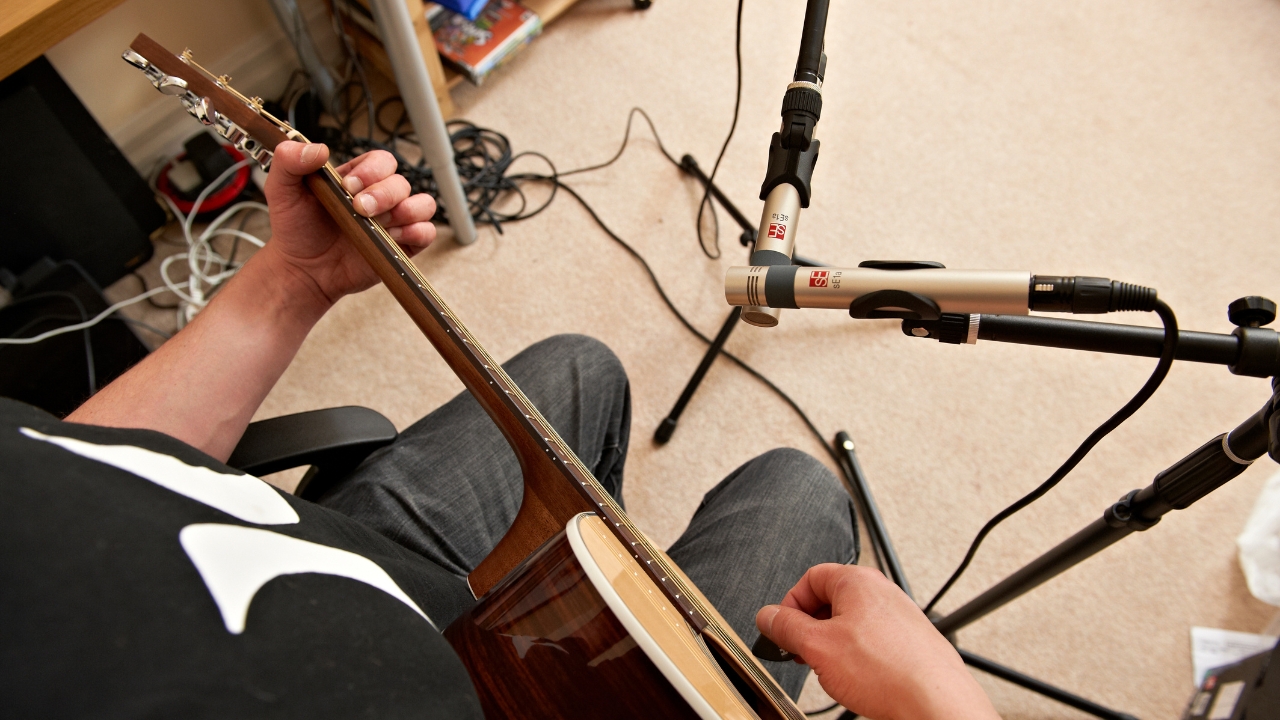
Unlike your voice, or to some extent an electric guitar speaker, where it’s easy to pinpoint exactly where the sound is coming from, an acoustic guitar is more perplexing. Yep, it looks like the sound should be focused around the sound hole but that’s only half the story. In fact, the whole body and the strings are alive with a wide variety of frequencies, and there’s handling noise to account for too.
The following set-ups will work well both in the studio and live on stage.
Where to place a single mic set-up?
Aim the mic at the obvious place – directly at the sound hole – and it’ll be overwhelmed by a build-up of bass resonance, making for a boomy recording or performance. Instead, to find the sweet spot for both warmth and clarity, move it east a bit, so it’s pointing at the junction between the guitar’s body and neck. This will typically be around the 12th – 14th frets.
If it still sounds too muddy, move it up the neck slightly – gently does it, just small increments at a time – but if you’re beginning to hear too much treble and annoying finger noise bring it back down towards the body again. All guitars and all mics behave differently, so it’s a matter of trial and error. Of course, as previously mentioned, small diaphragm condensers are a natural for this, because they can be aimed with great accuracy.
If the results are consistently boomy or thin, then play about with the distance between the mic and the guitar. Generally speaking, when recording you’ll want to get the best signal to noise ratio possible, which means bringing the mic right up close to the sound source. However, there are potentially two issues with this. Firstly, position the mic too close and it may interfere with your fretting hand. Second, the proximity effect will come into play, which manifests as a boost in bass frequencies.
Some microphones are much more prone to the proximity effect than others, and while some do add a pleasing warmth many just suffer a thick layer of muddiness. So, final placement will depend on your guitar, your mic and your playing style, but 6” to 12” should do the trick. Another good reason for placing the mic away from the guitar is so that you can pick up room ambience and natural reverb, which may be desirable. Or not. It’s your choice.
Is a multi-mic set-up worth it?
As you can probably imagine, multi-mic rigs can quickly become horribly time-consuming to set up successfully, and you must consider lots of additional issues such as phase. That said, there are a couple of established dual mic configurations that aren’t too much of a burden and sound fantastic.
Spaced pair (A/B) uses two mics in separate positions, often a small diaphragm condenser at the 12th fret and a large diaphragm condenser at the bridge. The small diaphragm condenser will pick up a clear, transparent rendition, while the large diaphragm is there to add body, ambience and warmth. Done right, the result will sound huge.
Just make sure you set up each mic individually first before playing with the stereo mix or you risk losing yourself in hours of sonic befuddlement.
A coincidental pair looks to achieve similar results but this time the mics are stacked one on top of the other, aimed 90 degrees apart in a V formation. The 12th fret is a good place to start, so that one is picking up clarity from the neck while the other is finding richness from the body. Adjust left/right and back/forth until you find the sweet spot. The advantage of a coincidental pair over a spaced pair is that you’re far less likely to suffer phase cancellation issues.
Finally, before you press the big red record button, or pick your first notes in front of a live audience, make sure your guitar is in tune. It’s so common to spend hours on setting up sophisticated mic placements, only to forget the basics.
Microphone types
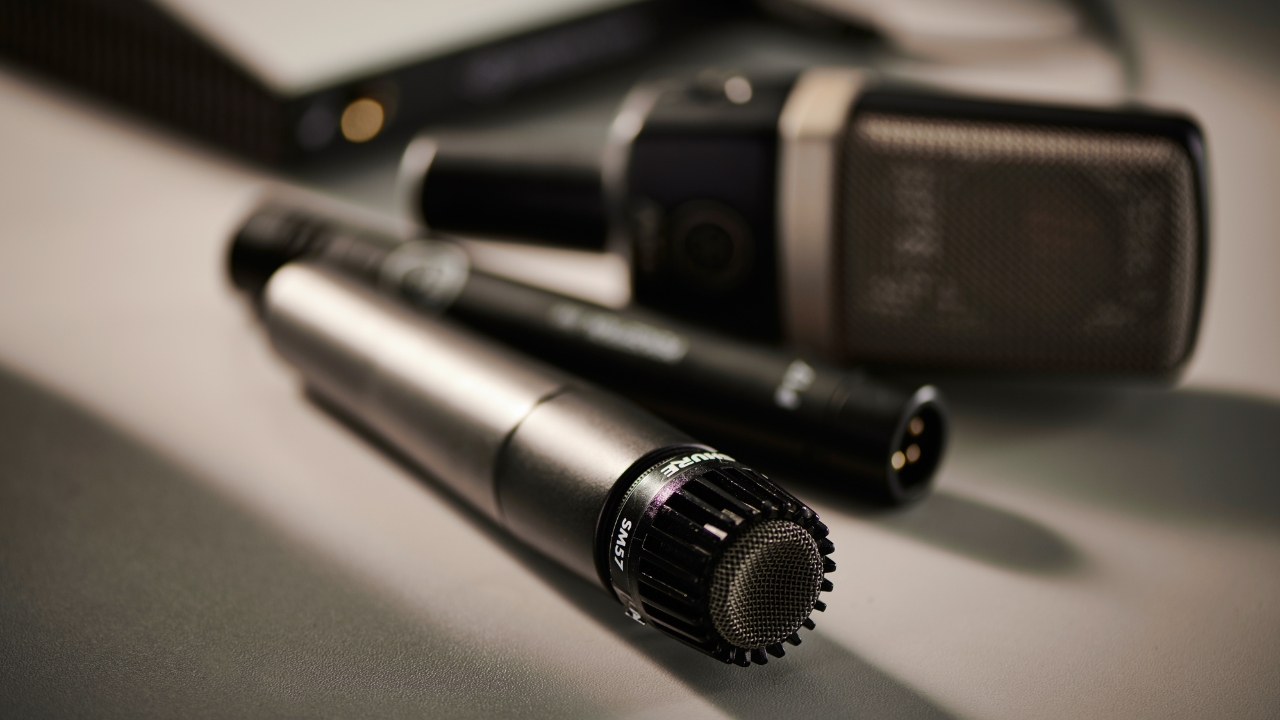
There are three core types of microphones that you are likely to come across that are best suited for recording acoustic guitars: condenser, dynamic, and ribbon. Each has its own advantages and disadvantages and none are right or wrong for recording acoustic, but have qualities that may make them more optimized for your needs.
Dynamic microphones
You can trust Guitar Player.
Dynamic microphones are trusted and reliable when it comes to all sorts of microphone applications, from recording vocals to drums, to acoustic guitar. Often among the cheaper microphones on the market, dynamic microphones typically feature a cardioid pickup pattern that makes them very directional, which is great for picking up a single sound source in a room with lots of noise.
Dynamic microphones are also very hardy, with the ability to be bashed about and still function the next day, and can be subject to high sound pressure levels without breaking—although it’s unlikely you will ever reach extreme sound pressure levels with an acoustic guitar. For all these reasons, dynamic microphones are typically the choice of the touring musician, facing up to hundreds of shows across the years and continuing to deliver.
A dynamic microphone may not be quite as appealing for you if you play your guitar softly, as they aren’t quite as responsive or nuanced as other microphone types, but players who strum should find they do the job perfectly.
Condenser microphones
Whilst in a live environment it is likely you’ll see a dynamic microphone applied to an acoustic, in the studio it is the condenser microphone that is arguably the default for acoustic recording. Featuring a wide frequency response and super sensitivity to transients, condenser microphones are perfect for picking up all the little nuances in acoustic guitar performances.
This can be a negative for live environments, where a condenser microphone may pick up sounds from other instruments or crowd noise. Combined with the fact that they are also more delicate than dynamic microphones, it may be that players looking specifically for a live microphone avoid condenser microphones.
The versatility of condenser microphones is one of the top reasons they are chosen for acoustic guitar, being equally adept at recording finger-picked guitar, to strummed chords, maintaining clarity throughout. This versatility can come at a price, with the very best condensers costing in the thousands. Fortunately, you can pick up really excellent condenser microphones for relatively affordable prices too.
Some condenser microphones also have variable pickup patterns, meaning you can pick up the sounds from various directions, which can be a fantastic trick to get ambient recordings in characterful environments, particularly when applied in stereo recording setups.
Ribbon microphones
Ribbon microphones have beautiful vintage tones that work superbly well with acoustic guitars, providing a warm and natural sound, with lots of low-end clarity and a smooth high-end, which differs from condenser microphones which can feel much brighter.
Ribbon microphones typically record in a figure-of-8 pickup pattern, which means they pick up sound from the front and back equally—image looking down from above and seeing a figure of 8 with the microphone at the center point of the 8; this is the area that picks up sound with a figure of 8 microphone. This can be really lovely when recording acoustic guitar with lots of additional ambiance, however, it requires a controlled space with little other sound, as this can really muddy your acoustic recording.
Their big drawback is that many ribbon microphones require a lot of preamp gain to pick up quiet playing, such as finger-picked guitar. This can introduce unwanted noise into your acoustic recording if you are not using high-quality preamps. The good news is that there are now options on the market that feature their own inbuilt preamp that activates when subject to 48V phantom power, reducing the need for external preamp gain. Please check whether your ribbon microphone is active or passive before switching on the phantom power, as they are very delicate, and passive ribbon microphones can be damaged if they receive 48V.
FAQs
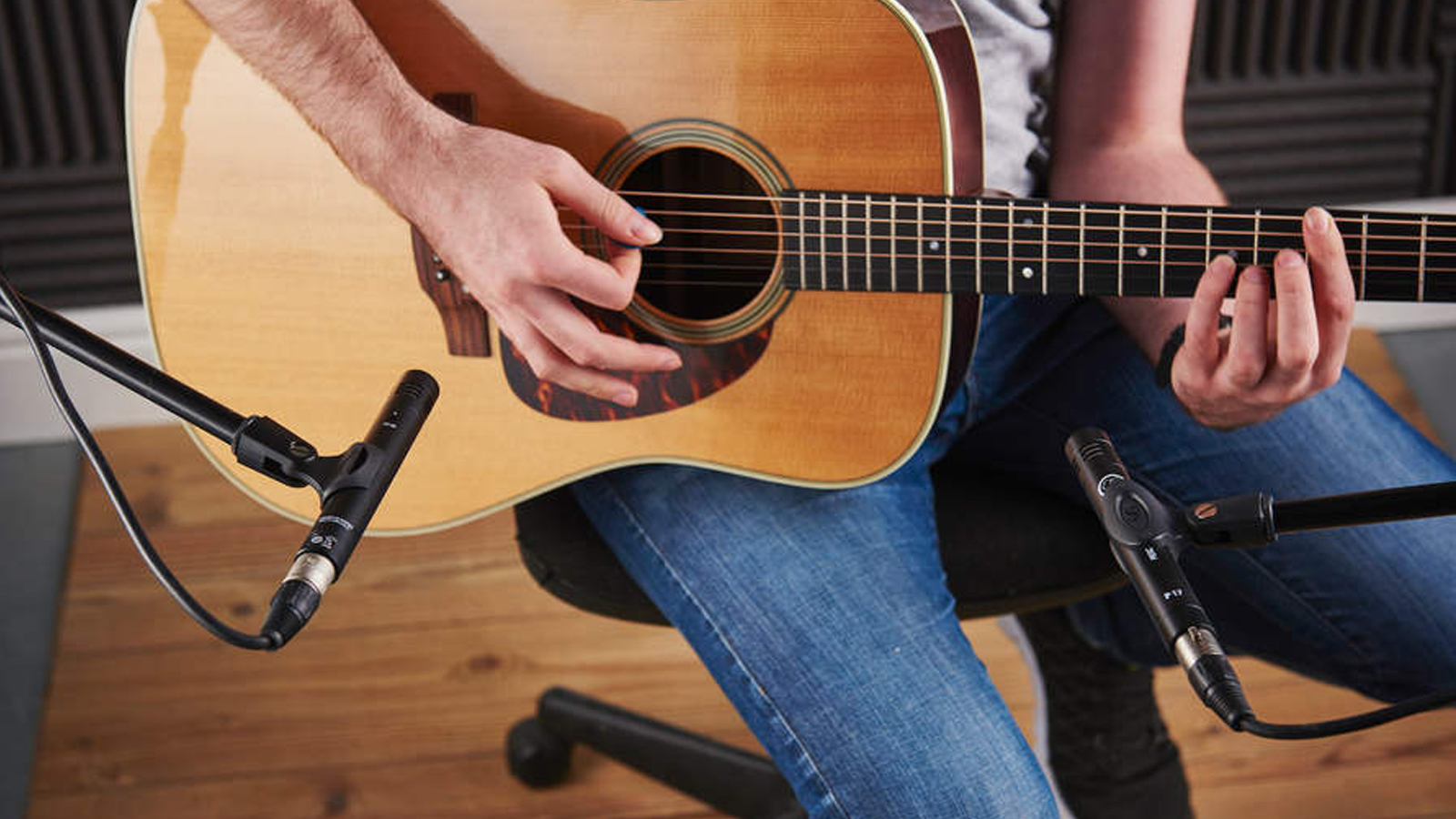
We're sure you’ll agree that the acoustic guitar is easily the most tactile and expressive musical instrument you can play. For a start, it covers such a broad range of frequencies and tones, from shimmering, transient-rich highs to rich, complex bass notes. What’s more, as guitarists, we can actually feel the vibrations coursing through our bodies.
Communicating this extraordinary timbre, complex sonic texture, and broad range and palpable feel in a live setting or a recording can be challenging. So, what follows is a brief primer on the different microphone types you’re likely to encounter, and where to place them for the very best results.
Should I buy a condenser mic?
Condenser microphones are the go-to mics for recording acoustic guitar, not just because they have a wide frequency response that can easily capture an acoustic’s frequency range but because they excel at highly detailed recordings.
Typically, a guitar’s rich, sonorous bass starts at about 100Hz, while the shimmering highs peak at around 10KHz, which is well within the scope of most mics. The challenge is capturing enough high-end detail, in particular high-frequency transients, which are the short bursts of sonic energy heard when a note is first sounded (in this case plucked or hammered).
Fortunately, all condenser mics have highly sensitive active capsules, so they’re more than up to the job. The trick is whether to go large or small.
Condenser mics come in two flavors: large diaphragm and small diaphragm. Large-diaphragm microphones are a favorite with vocalists because they flatter the voice with a touch of warmth, particularly the low end. They sound ‘big’, lush, and complex – absolutely gorgeous!
Unsurprisingly, to house a sizable diaphragm, which is often about an inch across, large diaphragm mics are usually quite big lumps and, more often than not, side-address (ie its primary axis is pointing out from its side). As you can probably imagine, they’re fantastic for capturing and subtly warming up the rich bass of an acoustic guitar.
Small diaphragm condenser mics, on the other hand, are simply superb at capturing a neutral, very highly detailed account of any sound source, including the acoustic guitar. Their transient response is off the charts, and because they’re small, and usually end-address, they are easy to position with accuracy. This point-ability is a quality that’s absolutely vital when recording an acoustic guitar, something we’ll touch on later.
Our advice is to invest in a good small diaphragm condenser mic if you’re planning to record your guitar using a single-mic mono set-up. If you have the budget and don’t mind the additional complexity that a multi-mic set-up requires, then consider a large condenser for your second mic.
What about dynamic microphones?
Dynamic mics lack the sensitivity of condenser microphones, yet they still have a role to play. Their inherent toughness makes them the natural choice for live performance and their ability to reject noise means they’re often the best choice for recording in busy and/or untreated rooms. Most can easily cope with a guitar’s frequency range, but they do struggle with detail and transients.
In some circumstances, this lack of high-end can be an advantage. Because dynamic mics also shrug off high sound pressure levels (SPL) they’re great for recording exuberant strummers or players who include a lot of loud high-frequency percussive playing, or who just suffer from handling squeaks and squeals. A good dynamic mic can handle the levels while rejecting much of the unwanted noise.
Are ribbon mics worth it?
Ribbon microphones date back to the 1920s and for decades were the de facto mics for broadcast and for recording instruments, including guitars. Then, when transistor technology took hold in the 1950s, condenser mics surged in popularity and ribbon mics fell out of fashion.
Which is a shame, because ribbon mics are unparalleled for capturing highly detailed, transparent, authentic recordings with a smoothness that no other mic can match. Part of the reason for their historic downfall was that the ultra-thin foil ribbon they use in place of a diaphragm and coil is susceptible to damage if mishandled. More significantly, they are passive microphones that need a high-impedance preamp capable of supplying a very large dollop of gain, which makes them impractical for many users.
The good news is that ribbon mics are now back and rising in popularity. Many of the newest versions have active circuitry that does away with the need for a high-impedance, high-gain preamp and, to some extent, protects the foil ribbon from failure.
Are Onboard Mic/Pickup Systems worth a look?
An increasingly popular microphone for acoustic guitars are pickup/microphone hybrid systems, which pair some form of pickup (often transducer) with a tiny condenser microphone mounted inside the guitar’s soundhole. In many ways, this gives you the best of both worlds and many allow you to blend as much of the pickup with the microphone as you like.
These setups are particularly useful if you’re not sure where to place a microphone for recording, as they’re positioned ready to go, however, they may not capture as much of the resonance that an acoustic exhales from every inch of its wooden body and neck—all the bits that give an acoustic its ‘star quality’. An external microphone is much more adept at this, so integrated mic/pickup combos are generally more suited for live performance, than studio use.
Where should my microphone go?
Depending on the type of microphone you have, you may find it has a particularly directional pickup pattern—the area that the microphone picks up sound from—which can mean that even fairly small movements can drastically alter your recording.
It feels obvious that pointing a microphone to where the sound emanates from—the sound hole—would be the smartest option, however, this may produce vast amounts of low end, and depending on how closely you position your microphone, this can also produce proximity effect, which emphasizes bass frequencies even more. It’s always wise to leave 6-12” between the microphone and acoustic guitar to avoid this overwhelming boom brought on by the proximity effect.
There is no right or wrong way to mic up an acoustic guitar and variables such as the room you are recording in can alter the sound drastically, so trial and error is usually a necessity, but as a general rule of thumb, you should get good results when pointing a cardioid microphone around the bottom third of your acoustic’s neck. If this still feels a little boomy, simply point it further up the neck, or if it’s feeling a little thin, bring it further towards the sound hole.
Every acoustic will be a little different, so microphone positioning isn’t one size fits all and a little trial and error is always worthwhile. Nothing beats what you hear with a pair of ears, so if you have somebody to help you record, get them to listen in different areas around your acoustic guitar while playing to find the sweet spot and then put a microphone there!
Can I use more than one microphone?
Yes, and we highly recommend trying it. Condenser microphones with variable pickup patterns play particularly well when used in pairs, whether that’s spaced, or using more adventurous techniques such as the Blumlein pair—where two microphones in figure-of-8 pickup patterns are put with their heads touching and facing 90 degrees from each other.
Alternatively, using multiple microphones may be the perfect opportunity to combine microphone types and characteristics, for example, a close-up dynamic microphone to capture the attack of your acoustic and a more ambient condenser to pick up the resonances of the room.
Whenever using multiple microphones on one sound source, beware of phase issues—where two versions of the same audio signal cancel each other out. A simple but effective way to avoid this is to use the 3:1 rule, which states that for every unit of distance between the microphone and the sound source, the second microphone should be at least three times that distance from the first microphone.
How we test
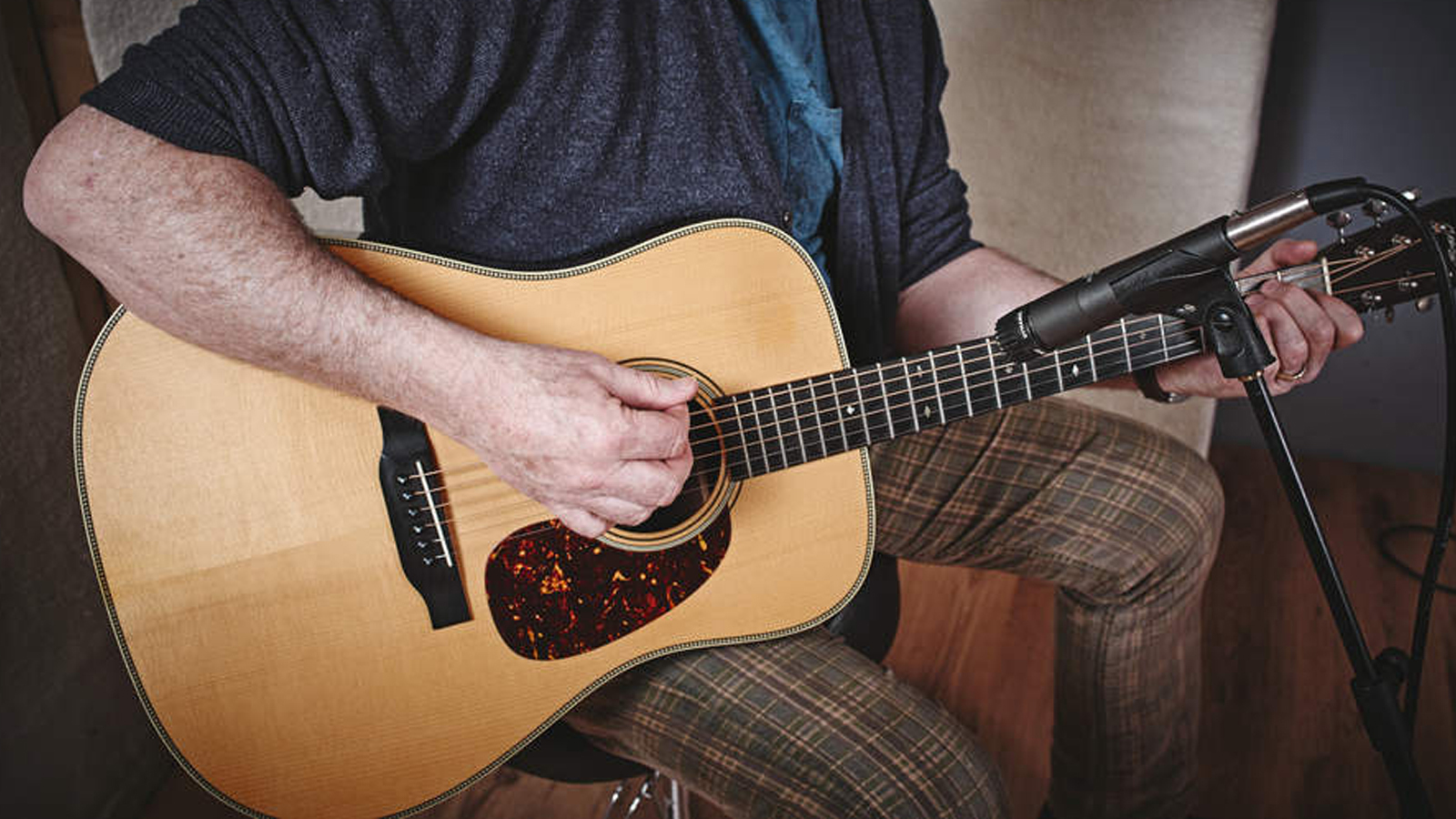
At Guitar Player, our team of passionate guitarists understands the power and creative possibilities the right microphone offers. With our deep appreciation of home and studio recording, we have extensively tested and analyzed numerous microphones to identify the best options available.
To compile our list of the best acoustic guitar mics, we combine our practical expertise, meticulous research and insightful discussions with our editorial team. We consider factors such as sound quality, functionality, ease of use, durability, and value for money, ensuring that we showcase the finest mics on the market.
Read more on how we test gear and service at Guitar Player.
Related buyer's guides
- Best Martin Guitars: 11 Top Choices From Budget To Premium
- Best acoustic guitars under $500: Top value picks
- The best acoustic guitars under $1,000: Great sound and value
- Best acoustic guitar strings: From budget to boutique
- Want to improve your acoustic recordings? Read this
- Best acoustic guitar pedals: 12 pedals players need to check out
- How to choose the right acoustic guitar pickup
- Acoustic guitar recording tips from a Nashville studio master
- Five pro tips to help you get the most from your gear
All the latest guitar news, interviews, lessons, reviews, deals and more, direct to your inbox!
- Connor Godfrey
- Matt McCrackenJunior Deals Writer
